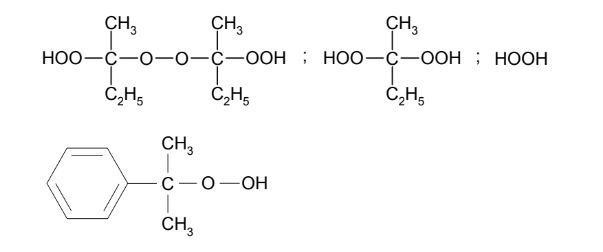Enhanced TDS
Identification & Functionality
- Chemical Family
- Chemical Name
- Manufactured By
- Plastics & Elastomers Functions
- Technologies
- Product Families
- Chemical Structure

Applications & Uses
- Compatible Polymers & Resins
- Plastics & Elastomers End Uses
- Thermal stability
Organic peroxides are thermally unstable substances, which may undergo self-accelerating decomposition. The lowest temperature at which self- accelerating decomposition of a substance in the original packaging may occur is the Self-Accelerating Decomposition Temperature (SADT). The SADT is determined on the basis of the Heat Accumulation Storage Test.
For Trigonox 178 SADT : 60°C (140°F)- Application Information
Trigonox 178 is a convenient pre-blended initiator suitable for curing unsaturated polyester, vinyl ester and acrylic thermosetting resins at ambient conditions in conjunction with a metal salt. Trigonox 178 produces lower exotherms than standard MEKP’s and is useful in warm and hot weather climates. Applications include cast polymer and laminates. Additional end-use information is available in various application sheets or directly from your AkzoNobel representative.
Properties
- Physical Form
- Appearance
- Clear liquid (at 20 - 25°C)
- Typical Properties
Value Units Test Method / Conditions Self-Accelerating Decomposition Temperature 60 °C - Maximum Storage Temperature 30 °C - - SDS Physical and Chemical Properties
Value Units Test Method / Conditions Oxidising Properties Not classified as oxidising - - Appearance Colorless liquid - - Organic Peroxides 58 - 63 % - Active Oxygen Content 9.1 % - Explosive Properties Not Explosive - - Self-Accelerating Decomposition Temperature 60 °C SADT Decomposition Temperature SADT - Self accelerating decomposition temperature is the lowest temperature at which self accelerating decomposition may occur with a substance in the packaging as used in transport. A dangerous self-accelerating decomposition reaction and, under certain circumstances, explosion or fire can be caused by thermal decomposition at and above the SADT. Contact with incompatible substances can cause decomposition below the SADT - - Insoluble in Water (at 20°C) - - Odor Characteristic - - Flammability Solid and Gas - - Flash Point Above the SADT value - - Boiling Point Decomposes below the boiling point - - Soluble in Most organic solvents - - - Characteristics
Value Units Test Method / Conditions Active Oxygen Content 9.1 % -
Regulatory & Compliance
Safety & Health
- Safety Information
Keep away from open fire, sparks and other sources of heat or ignition. Avoid contact with reducing agents (e.g. amines), acids, alkalis and heavy metal compounds (e.g. accelerators, driers and metal soaps). Please refer to the Material Safety Data Sheet (MSDS) for further information on the safe storage, use and handling of Trigonox 178. This information should be thoroughly reviewed prior to acceptance of this product.Keep away from open fire, sparks and other sources of heat or ignition. Avoid contact with reducing agents (e.g. amines), acids, alkalis and heavy metal compounds (e.g. accelerators, driers and metal soaps).
Packaging & Availability
- Country Availability
- Packaging Information
Trigonox 178 is packed in non-returnable, one gallon polyethylene containers of 8 lb net weight (4 per case).
Both packaging and transport meet the international regulations. For the availability of other packed quantities contact your AkzoNobel representative.
Trigonox 178 is classified as Organic peroxide type D; liquid; Division 5.2; UN 3105.
Storage & Handling
- Shelf Life
- 3 years
- Storage Information
Due to the relatively unstable nature of organic peroxides a loss of quality can be detected over a period of time. To minimize the loss of quality, AkzoNobel recommends a maximum storage temperature (Ts max.) for each organic peroxide product.
For Trigonox 178 Ts max. = 30°C (86°F)
When stored under these recommended storage conditions Trigonox 178 will remain within the AkzoNobel specifications for a period of at least 3 months after delivery.
